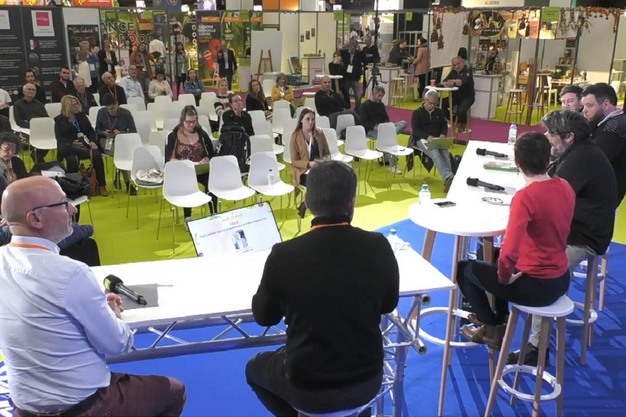"What diversification is possible in the face of climate change?" This was the subject of one of the conferences at medFEL 2024. Pomegranates, avocados, almonds, citrus and exotic fruits: many trials and new plantations have been launched in recent years in the region. Faced with climate change, many growers have turned to diversification. Stéphane Durand, fruit and vegetable sector manager at Biocoop, is developing diversification programs "in view of the increase in climatic hazards." These emerging crops would also meet "the increasingly strong demand from distributors for products of French origin," explains Tristan Margalet, CEO of Greype France, who wants to introduce new crops and develop its own production of French citrus fruits.
What might the French agricultural landscape look like in a few years' time? What new sectors are taking shape? A case in point, with clementine and pistachio trials in the south of France.
 This medFEL conference looked at possible paths to take and new plantings in the south of France were discussed as well, with a focus on pistachios and clementines. The speakers included Yannick Chevrier, director, Coop La Tour, Benoît Dufaÿ, France Pistache project manager, Tristan Margalet, CEO of Greype France, Mathieu Donati, associate producer of Agrucorse and Stéphane Durand, director of fruit and vegetable sector at Biocoop.
This medFEL conference looked at possible paths to take and new plantings in the south of France were discussed as well, with a focus on pistachios and clementines. The speakers included Yannick Chevrier, director, Coop La Tour, Benoît Dufaÿ, France Pistache project manager, Tristan Margalet, CEO of Greype France, Mathieu Donati, associate producer of Agrucorse and Stéphane Durand, director of fruit and vegetable sector at Biocoop.
"Finding the product that works agronomically and commercially"
Diversification is necessary, but what diversification is possible? The challenge is to find the right varieties, according to Yannick Chevray, director of the Roussillon La Tour cooperative (based in the Pyrénées-Orientales region), who had to find alternatives after being hit by the Sharka virus. "We have to find a product that works both agronomically and commercially. The challenge is to maintain current production levels while ensuring the survival of the structure and its growers, by diversifying and choosing species adapted to climate change but also adapted to the market." After several tests, the 100% organic cooperative opted for clementines because "generally speaking, clementines are a commercially established product." The first plantings were carried out 5 years ago, at a time when the department was not experiencing the same water shortage problems as today. "Last year, we realized that clementines are very resilient to drought. If last year's water shortage had affected the peach and nectarine production, we would have lost everything."
Benoit Dufay, project manager at France Pistache, which gathers a large number of French producers of the PACA region, explains why some growers are turning to pistachios. "It benefits from a dynamic market with a negative trade balance, because we do not produce any. The advantage is that pistachio trees are adapted to a dry, hot climate with very low water requirements."
Towards two new French sectors?
In 2018, the France Pistache union was born, which federates no less than 110 producers today. "We quickly decided to create a sector to develop collectively. Today, production covers 450 hectares in France, from PACA to Occitania, via Corsica," explains Benoît Dufaÿ, project manager of France Pistache. The crop is still in its infancy, with 30 kilos of pistachios harvested last year. "Production starts 6 years after planting, and it takes 10 years to reach significant yields."
The pistachio sector has already been created, but everything still needs to be done in the citrus sector. A "Roussillon clementine" sector could even see the light of day. "With our partners, we want to create a sector," explains Yannick Chevrier. "But first, we need to define certain things such as packaging, size, price…"
"What happens in Corsica today will happen all over France tomorrow"
"Tomorrow, Corsica may well be the clementine capital of the Mediterranean," explains Mathieu Donati, associate producer at citrus specialist Agrucorse. "Corsica is something of a sentinel for what is happening in the south of France, because climate change is coming from the south, and we are seeing a shift in all types of production towards the north. What is happening in Corsica is therefore of interest to all French farmers", as the island could well become "the clementine capital of the Mediterranean." Introduced to Corsica massively in the 1960s, frost and cold have taken their toll on the orchards, which have shrunk from 3,000 ha to 1,000 ha. "Today, with climate change, we are back up to 2,000 ha." But Corsica wants to become a citrus specialist and improve the range. After the clementine and pomelo PGI, two other PGIs could be launched: this time for lemons and oranges. Agrucorse is also conducting trials on a mandarin variety, the W9, which is "seedless and easy to peel."
Does the yellow dragon disease constitute a new threat?
"We do not know when, but we know it is going to happen," explains Mathieu Donati, of HLB (Huanglongbing), also known as yellow dragon disease, a deadly bacterial disease of citrus fruits. Already present in most citrus-growing regions, HLB is now threatening the Mediterranean area, with the arrival of the psyllid (vector insect). "It is the main issue threatening the Mediterranean basin, because the danger comes from both sides, arriving via Portugal and Turkey. Although Corsica is an island, we are developing a strategy to stop importing plant material from abroad, and we are working hard on resistant rootstocks."
For more information: www.medfel.com

